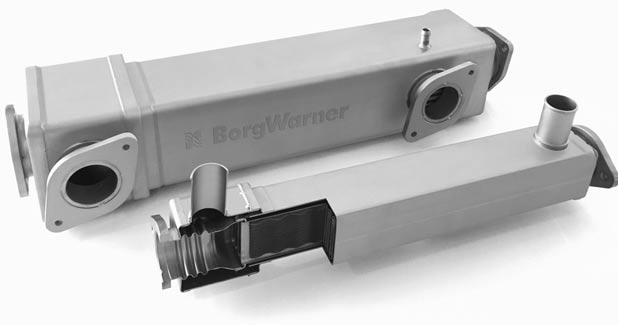
BorgWarner develops new EGR coolers for commercial vehicles
To support commercial vehicle manufacturers in meeting current and future emissions regulations, BorgWarner has developed an economical new series of multi-platform exhaust gas re-circulation (EGR) coolers featuring a compact floating core. Unlike conventional solutions which must be specifically designed for each application, this new modular cooler family includes four highly adaptable standard designs for maximum flexibility covering a wide range of engine sizes from 2 to 16 litre displacement, according to the company. The new EGR solution offers high robustness against thermal fatigue and enhanced coolant distribution for durable performance even with minimum coolant flow, while reducing NOx emissions.
?With lower production volumes and high durability requirements, the commercial vehicle segment needs an EGR solution that provides outstanding performance and reduces complexity at the same time,? said Joe Fadool, President and General Manager, BorgWarner Emissions & Thermal Systems. ?Offering high flexibility and durability, our newly developed EGR coolers have already piqued the interest of several manufacturers that see the potential for a cost-effective solution to help meet increasingly stringent emissions regulations.?
Featuring hybrid tube heat transfer technology and a floating inner core, BorgWarner?s EGR coolers are designed to resist high levels of thermal load. In addition, the system provides enhanced coolant distribution, which enables durable performance even with minimum coolant flow. BorgWarner integrated a thermomechanical damper into the design to facilitate complete decoupling of the shell and inner core components to absorb longitudinal and angular differences for improved durability. The damper also provides some initial extra cooling for the inlet gas to reduce thermal shock and allows better gas distribution to the tubes to resist thermal fatigue. In addition, cooling the damper and inlet gas box reduces the overall temperatures achieved, which in turn significantly lowers thermal stress.
When the system is operated at an exhaust gas temperature of 1,562?F (850?C), the inlet gas box temperature is kept below 392?F (200?C), compared to more than 1,292?F (700?C) without cooling. The advanced design also minimises the effect of the engine transients over the EGR cooler?s durability. The four new coolers allow the standardisation of most of the components from one application to another, with the exception of the housing and the mounting fixtures, resulting in maximum adaptability for robust, tailor-made solutions and high cost-efficiency.
?With lower production volumes and high durability requirements, the commercial vehicle segment needs an EGR solution that provides outstanding performance and reduces complexity at the same time,? said Joe Fadool, President and General Manager, BorgWarner Emissions & Thermal Systems. ?Offering high flexibility and durability, our newly developed EGR coolers have already piqued the interest of several manufacturers that see the potential for a cost-effective solution to help meet increasingly stringent emissions regulations.?
Featuring hybrid tube heat transfer technology and a floating inner core, BorgWarner?s EGR coolers are designed to resist high levels of thermal load. In addition, the system provides enhanced coolant distribution, which enables durable performance even with minimum coolant flow. BorgWarner integrated a thermomechanical damper into the design to facilitate complete decoupling of the shell and inner core components to absorb longitudinal and angular differences for improved durability. The damper also provides some initial extra cooling for the inlet gas to reduce thermal shock and allows better gas distribution to the tubes to resist thermal fatigue. In addition, cooling the damper and inlet gas box reduces the overall temperatures achieved, which in turn significantly lowers thermal stress.
When the system is operated at an exhaust gas temperature of 1,562?F (850?C), the inlet gas box temperature is kept below 392?F (200?C), compared to more than 1,292?F (700?C) without cooling. The advanced design also minimises the effect of the engine transients over the EGR cooler?s durability. The four new coolers allow the standardisation of most of the components from one application to another, with the exception of the housing and the mounting fixtures, resulting in maximum adaptability for robust, tailor-made solutions and high cost-efficiency.


 +91-22-24193000
+91-22-24193000 Subscriber@ASAPPinfoGlobal.com
Subscriber@ASAPPinfoGlobal.com